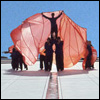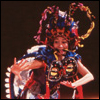Good News
Los Angeles Times Magazine, July 5, 1987
China Dancer
An American Takes Contemporary Western Dance to Guangzhou
By Bevis Hillier
When I first traveled through mainland China - for four weeks - in 1979, Chairman Mao Tse-tung was still alive. Our itinerary included reverential visits to his birthplace and his school. Although the British-based art magazine that organized the tour had 75% of its subscribers in the United States, no Americans were permitted to take part. And where ever we went, we were shown anti-American propaganda films.
Thing have changed. In 1986 the Chinese Ministry of Culture invited an American to come to Guangzhou (Canton) to help set up a Contemporary Dance Institute - which will be officially opened on September 15. The fact that the American has a Chinese name and was born in China 45 years ago is beside the point. The Chinese realized that if they wanted a truly contemporary dance institute, they needed the advice of someone familiar with the latest developments in the West. Yen Lu Wong, a leading figure in Los Angeles dance, fitted the fill. Dancer, choreographer and teacher, she founded the Los Angeles-based performance ensemble The New Repertory with her husband, Herbert Shore, in 1972.
In 1975, as a result of President Nixon's "Ping-Pong diplomacy, "Wong became one of the first two Chinese-Amerian artists to visit China. She was already involved with showing dance films from China, such as "White-Haired Girl" and "Red Detachment of Women." To go to China, she had to get a visa from Toronto since China still had no diplomatic representation in the United States. She went on her own and was allowed to go where ever she wished.
After diplomatic relations were re-established, Wang Zizheng, the Chinese minister for arts education, came to America. Wong was host to him at USC, where she is adjunct professor in the drama division. In 1984 the Chinese Ministry of Culture invited her and her company to go to China, to perform and to conduct a series of workshops. But the company could not afford to go. "We worked out the budget for the whole group," Wong says, "and it was so gigantic that - short of the State Department sending us - we knew we couldn't make the trip. So the minister said: 'Well, if you can't bring your group, why don't you come?' "Wong said she would think it over.
Meanwhile, the progressive principal of the already-existing Guangdong Dance Academy, in Guangzhou, a woman named Yang Mei Yang, received a grant to attend the American Dance Festival in 1986. She was enthusiastic about the contemporary dances she saw. Yang Mei Yang told Wong about her dream of creating a contemporary dance institute in China. Wong recalls: "She looked at me and said, 'I can't think of a better person than you.' So the through-line of action is that the Ministry of Culture in Beijing wanted me to go and help; but now I was able to say,'OK, let's not talk abstractly about modernization; let's work on this concrete project.' "
Wong arrived in Guangzhou in September, 1986, and remained there for five weeks. The task of "modernizing" Chinese dane was daunting, but Yen Lu Wong saw that she had one big advantage. "Dance is taken seriously in China," she says. "It is a profession, just like engineering or medicine." But there were some obstacles, too - chief among them, the permeation of Chinese dance by Soviet ballet techniques. "You have to remember," Wong explains, "that from the revolution of 1949 onwards, for some years China was not aided by anyone except the Soviet Union. The Chinese used the Kirov method to study Chinese classical dance, and they have a very balletic version of Chinese classical dance."
Wong decided her best plan of attack was to teach the teachers."If I could teach 50 teachers, essentially I would be teaching 50,000 students. So I requested only teachers." They ranged in age from the early 20s to the early 50s. "They rolled up their pants and just jumped in," she says. But Wong thought it was not enough to teach them contemporary dance steps. "That would be just giving them fish. I needed to teach them how to fish." So she showed them video films of American and German contemporary dance.
"It was very interesting," Wong says, "because on the one hand you have the German choreographers, with their very intellectual approach, taking works such as Stavinsky's "Les Noces" or Schubert lieder and choreographing them. On the other you have the Americans, very energetic - great bursts of energy - but ultimately not as intellectual. The Chinese enjoy that burst-of-jazz sort of thing, but I think that ultimately they feel much more in tune with the German tradition."
Wong will return to Guangzhou in September for the Contemporary Dance Institute's grand opening, which will be attended by top choreographers from the United States, Britain, France, Germany, Sweden and Japan - but not from the Soviet Union. "Frankly, the Soviet Union hasn't made any mark in contemporary dance," Wong says.






